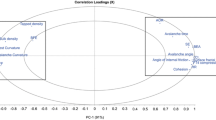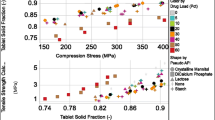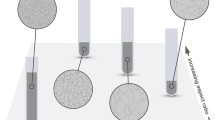Abstract
In powder technology, it is often important to directly measure real powder flow rate from a small amount of powder. For example, in pharmaceutical industry, a frequent problem is to determine powder flow properties of new active pharmaceutical ingredient (API) in an early stage of the development when the amount of API is limited. The purpose of this paper is to introduce a new direct method to measure powder flow when the material is poorly flowing (cohesive) and the amount of material is about 1 to 2 g. The measuring system was simple, consisting of a flow chamber and electronic balance and an automated optical detection system, and for each measurement, only 1 to 2 g of sample was required. Based on the results obtained with this testing method, three selected sugar excipients, three grades of microcrystalline cellulose, and APIs (caffeine, carbamazepine, and paracetamol) can be classified as freely flowing, intermediate flowing, and poorly flowing powders, respectively. The average relative standard deviation for the flow time determinations was not more than 2–10%. The present novel flowability testing method provides a new tool for a rapid determination of flowing characteristics of powders (e.g., inhalation powders) and granules at a small scale.








Similar content being viewed by others
References
Staniforth J. Powder flow. In: Aulton ME, editor. Pharmaceutics. The Science of Dosage Form Design, London: Churchill Livingstone, Elsevier Limited; 2002. p. 197–210.
Forsyth AJ, Hutton SR, Osborne CF, Rhodes MJ. Effects of interparticle force on the packing of spherical granular material. Phys Rev Lett. 2001;87(244301):1–3.
Antikainen OK, Rantanen JT, Yliruusi JK. Use of the Kohonen self-organizing map to predict the flowability of powders. STP Pharma Sci. 2000;10:349–54.
Thronton C, Zhang L. Numerical simulations of the direct shear test. Chem Eng Technol. 2003;26:153–6.
Gröger T, Tüzün U, Heyes DM. Modelling and measuring of cohesion in wet granular materials. Powder Technol. 2003;133:203–15.
Tomas J. Fundamentals of cohesive powder consolidation and flow. Granular Matter. 2004;6:75–86. doi:10.1007/s10035-004-0167-9.
Moreno-Atanasio R, Antony SJ, Ghadiri M. Analysis of flowability of cohesive powder using distinct element method. Powder Technol. 2005;158:51–7.
Schwedes J. Review on testers for measuring flow properties of bulk solids. Granular Matter. 2003;5:1–43.
Kaye BH, Gratton-Liimatainen J, Lloyd J. The effect of flowagents on the rheology of a plastic powder. Part Part Syst Char. 1995;12:194–7.
Lee YSL, Poynter R, Podczeck F, Newton M. Development of a dual approach to assess powder flow from avalanching behaviour. AAPS PharmSciTech. 2000;1:44–52.
Hancock BC, Vukovinsky KE, Brolley B, Grimsey I, Hedden D, Olsofsky A et al. Development of a robust procedure for assessing powder flow using a commercial avalanche testing instrument. J Pharm Biomed Anal. 2004;35:979–90.
Freeman R. Measuring the flow properties of consolidated, conditioned and aerated powders—a comparative study using a powder rheometer and a rotational shear cell. Powder Technol. 2007;174:25–33.
Carr JF, Walker DM. An annular shear cell for granular materials. Powder Technol. 1968;1:369–73.
Ramchandruni H, Hoag SW. Design and validation of an annular shear cell for pharmaceutical powder testing. J Pharm Sci. 2001;90:531–40.
Walker DM. An approximate theory for pressures and arching in hoppers. Chem Eng Sci. 1966;21:975–97.
Jolliffe IG, Newton JM, Waiters JK. Theoretical considerations of the filling of pharmaceutical hard gelatin capsule. Powder Technol. 1980;27:189–95.
Tan SB, Newton JM. Powder flowability as an indication of capsule filling performance. Int J Pharm. 1990;61(1–2):145–55.
Flemming J, Mielck JB. Requirements for the production of micro-tablets: suitability of direct-compression excipients estimated from powder characteristics and flow rates. Drug Dev Ind Pharm. 1995;21:2239–51.
Hou H, Sun CC. Quantifying effects of particulate properties on powder flow properties using a ring shear tester. J Pharm Sci. 2008;97:4030–9.
Sun CC. Improving powder flow properties of citric acid by crystal hydration. J Pharm Sci. 2009;98:1744–9.
Crowder TM, Hickey AJ. An instrument for rapid powder flow measurement and temporal fractal analysis (short communication). Part Part Syst Charact. 1999;16:32–4.
Rios M. Developments in powder flow testing. Pharm Technol Eur. 2006;30:38–49.
Jiang Y, Matsusaka S, Masuda H, Qian Y. Development of measurement system for powder flowability based on vibrating capillary method. Powder Technol. 2009;188:242–7.
Council of Europe. European Pharmacopoeia 5th ed. Strasbourg: Council of Europe; 2004.
Author information
Authors and Affiliations
Corresponding author
Rights and permissions
About this article
Cite this article
Seppälä, K., Heinämäki, J., Hatara, J. et al. Development of a New Method to Get a Reliable Powder Flow Characteristics Using Only 1 to 2 g of Powder. AAPS PharmSciTech 11, 402–408 (2010). https://doi.org/10.1208/s12249-010-9397-9
Received:
Accepted:
Published:
Issue Date:
DOI: https://doi.org/10.1208/s12249-010-9397-9




